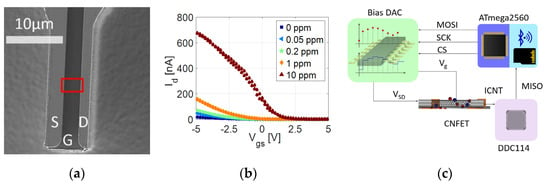Abstract
This work proposes a portable, software-defined NO2-sensing platform, which is able to acquire currents ranging from nA to µA from a Single-Walled Carbon Nanotube (SWCNT) gas sensor. It includes an embedded software that steers the system allowing dynamical adjustments of the SWCNT bias levels, measurement range, sampling rate and of measurement time intervals. Further, the embedded functions can post-process the measurement results, log data on an SD card or send data via a wireless connection.
1. Introduction
Recent studies have revealed that the annual number of premature deaths caused by total air pollution exceeds the mortality caused by AIDS and malaria combined [1]. NO2 air pollutant is one of the most-dangerous contributors and for this reason, air quality will be driving the demand for new gas sensors. This work proposes an embedded platform based on the SWCNT Field Effect Transistor (FET) architecture [2], which explores the potential of this nanomaterial as NO2 sensor.
A scanning electron microscope (SEM) image of a SWCNT on its micromachined substrate is shown in Figure 1a [3]. Figure 1b shows a typical p-type SWCNT-FET transfer characteristic. As depicted in Figure 1b, the SWCNT-FET experiences a shift in threshold voltage, as well as an increase in drain current, when exposed to NO2. The latter mode where the change in electrical conductance is related to the gas concentration / gas partial pressure will be used for signal detection in this work.

Figure 1.
(a) SEM of SWCNT (inside the red square) [reprinted with permission from IEEE] [3]; (b) SWCNT-FET transfer characteristic under various NO2 gas concentrations at Vds = 0.5 V; (c) block schematic of the platform.
2. Embedded Hardware and Software
The simplified block schematic of the platform is shown in Figure 1c. The platform integrates a SWCNT-FET device together with several integrated circuits (ICs). For the automation of the NO2-gas sensing routine, an event-triggered Finite-State Machine (FSM) runs on the microcontroller (µC). The set of states were software defined for each discrete action such as: programming the gate and drain voltages of the CNT sensor, controlling the charge-to-digital converter’s integration time and capacitor bank, storing measurement results on the SD card and/or transmitting the data via Bluetooth. An overview of the states and state transitions, together with the corresponding power consumption, is illustrated in Figure 2a.

Figure 2.
(a) Finite-state machine (FSM) states, transitions and power level; (b) CNT sensor response at various NO2 levels, Vgs = −5V; (c) platform power consumption in Active and IDLE modes.
3. Measurement Results
The platform was evaluated together with the CNT sensor under lab measurement conditions. The current sensor response in the range of ppm is shown in Figure 2b. In addition, an IDLE state was defined in order to switch off unnecessary peripherals and to set the µC into power-save mode. Figure 2c shows the power consumption of the platform when five samples where measured in a row followed by IDLE.
References
- Jiang, D.L. Environmental Gas Sensors 2018-2028. Available online: https://www.idtechex.com/en/research-report/environmental-gas-sensors-2020-2030/718 (accessed on 1 December 2020).
- Chikkadi, K.; Muoth, M.; Roman, C.; Haluska, M.; Hierold, C. Advances in NO2 sensing with individual single-walled carbon nanotube transistors. Beilstein J. Nanotechnol. 2014, 5, 2179–2191. [Google Scholar] [CrossRef] [PubMed]
- Eberle, S.; Roman, C.; Hierold, C. Optimizing Sensor Response in Suspended, Ultra Low Power CNT-FET NO2 Gas Sensors via Bias Tuning. 2019 20th Int. Conf. Solid-State Sensors, Actuators Microsystems Eurosensors XXXIII, TRANSDUCERS 2019 EUROSENSORS XXXIII 2019, 1301–1304. [Google Scholar] [CrossRef]
Publisher’s Note: MDPI stays neutral with regard to jurisdictional claims in published maps and institutional affiliations. |
© 2020 by the authors. Licensee MDPI, Basel, Switzerland. This article is an open access article distributed under the terms and conditions of the Creative Commons Attribution (CC BY) license (https://creativecommons.org/licenses/by/4.0/).